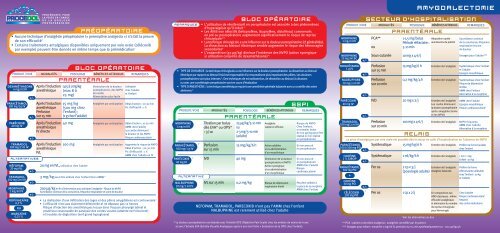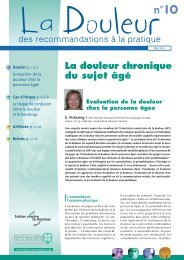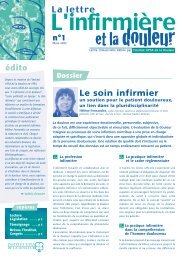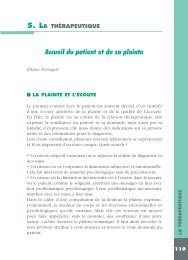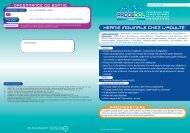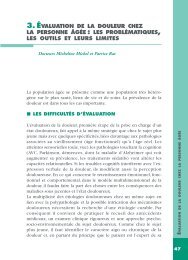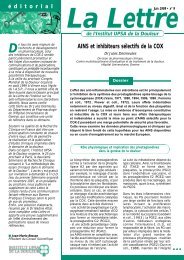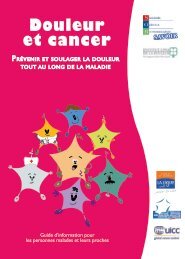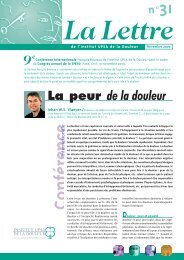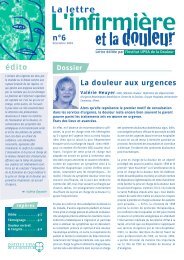Télécharger - Institut upsa de la douleur
Télécharger - Institut upsa de la douleur
Télécharger - Institut upsa de la douleur
You also want an ePaper? Increase the reach of your titles
YUMPU automatically turns print PDFs into web optimized ePapers that Google loves.
PRODUIT/VOIE<br />
ALTERNATIVEs<br />
PROCÉDURES POUR<br />
LA PRISE EN CHARGE<br />
DE LA DOULEUR<br />
POSTOPÉRATOIRE<br />
Après l’induction<br />
anesthésique<br />
Perfusion<br />
sur 15 min<br />
Après l’induction<br />
anesthésique<br />
IVL<br />
15 mg/kg<br />
(500 mg chez<br />
l’enfant);<br />
(1 g chez l’adulte)<br />
100 mg<br />
PRÉOPÉRATOIRE<br />
• Aucune technique d’analgésie préopératoire (« preemptive analgesia ») n’a fait <strong>la</strong> preuve<br />
<strong>de</strong> son efficacité 6<br />
• Certains traitements antalgiques disponibles uniquement par voie orale (célécoxib<br />
par exemple) peuvent être donnés en même temps que <strong>la</strong> prémédication 7<br />
<strong>de</strong>xaméthasone<br />
4 mg/ml iv<br />
paracétamol<br />
500 mg/1g iv<br />
parécoxib<br />
40 mg iv<br />
tramadol<br />
100 mg/2 ml iv<br />
néfopam<br />
20 mg ivl<br />
tramadol<br />
100 mg/2ml iv<br />
morphine<br />
1 mg/ml iv<br />
ropivacaïne<br />
0,2 %<br />
ou<br />
marcaïne<br />
0,25 %<br />
7<br />
8<br />
BLOC OPÉRATOIRE<br />
MODALITÉS POSOLOGIE BÉNÉFICES ATTENDUS REMARQUES<br />
Après l’induction<br />
anesthésique<br />
Après l’induction<br />
anesthésique<br />
IV directe<br />
PARENTÉRALE<br />
0,15 à 1 mg/kg<br />
(max 8 à<br />
25 mg)<br />
Diminution <strong>de</strong> <strong>la</strong> <strong>douleur</strong><br />
postopératoire, <strong>de</strong>s NVPO<br />
<strong>de</strong> moitié<br />
Alimentation plus facile<br />
Analgésie par anticipation<br />
40 mg Analgésie par anticipation Dé<strong>la</strong>i d’action : 10-20 min<br />
AMM chez l’adulte<br />
Les coxibs diminuent<br />
<strong>la</strong> <strong>douleur</strong> et les NVPO<br />
Risque cardiovascu<strong>la</strong>ire 9<br />
20 mg en IVL, utilisation chez l’adulte<br />
3 mg/kg peut être utilisée chez l’enfant (Hors AMM) 10<br />
Analgésie par anticipation<br />
200 µg/kg en fin d’intervention pour anticiper l’analgésie - Risque <strong>de</strong> NVPO<br />
Surveil<strong>la</strong>nce continue <strong>de</strong> <strong>la</strong> conscience, fréquence respiratoire et score <strong>de</strong> <strong>douleur</strong><br />
Utilisable<br />
chez l’adulte<br />
et l’enfant<br />
Dé<strong>la</strong>i d’action : 20-30 min<br />
Pic d’efficacité : 1 h<br />
Augmente le risque <strong>de</strong> NVPO<br />
Dé<strong>la</strong>i d’action : 20-30 min<br />
Pic d’efficacité : 1 h<br />
AMM chez l’adulte en IV<br />
• La réalisation d’une infiltration <strong>de</strong>s loges et <strong>de</strong>s piliers amygdaliens est controversée 11<br />
• L’efficacité n’est pas c<strong>la</strong>irement démontrée et ne dépasse pas 12 heures<br />
Risque d’injection <strong>de</strong>s anesthésiques locaux dans l’espace pharyngé <strong>la</strong>téral et<br />
postérieur responsable <strong>de</strong> paralysie <strong>de</strong>s cor<strong>de</strong>s vocales (atteinte nerf récurrent)<br />
et troubles <strong>de</strong> déglutition (nerf grand hypoglosse)<br />
REMARQUES<br />
• TYPE DE CHIRURGIE : <strong>la</strong> technique chirurgicale a une influence sur <strong>la</strong> <strong>douleur</strong> postopératoire. La dissection au bistouri<br />
électrique par rapport au bistouri froid est responsable d’un traumatisme plus important <strong>de</strong>s piliers. Les <strong>douleur</strong>s<br />
postopératoires sont plus intenses 15 . Des techniques <strong>de</strong> microdissection, <strong>de</strong> dissection au bistouri à ultrasons<br />
ou avec une cryothérapie peropératoire sont en cours d’évaluation<br />
• TYPE D'ANESTHÉSIE : <strong>la</strong> technique anesthésique requiert une anesthésie générale ba<strong>la</strong>ncée avec un contrôle <strong>de</strong>s voies<br />
aériennes 16<br />
PRODUIT/VOIE<br />
morphine<br />
1 mg/ml iv<br />
paracétamol<br />
500 mg/1 g iv<br />
parécoxib<br />
40 mg iv<br />
7<br />
17<br />
ALTERNATIVE<br />
nalbuphine<br />
20 mg/2 ml iv<br />
BLOC OPÉRATOIRE<br />
• L’utilisation <strong>de</strong> rémifentanil en peropératoire est associée à <strong>de</strong>s phénomènes<br />
d’hyperalgésie qu’il induit 12<br />
• Les AINS non sélectifs (kétoprofène, ibuprofène, diclofénac) commencés<br />
en pré ou postopératoire augmentent significativement le risque <strong>de</strong> reprise<br />
chirurgicale 5,13<br />
• La technique chirurgicale a une influence sur <strong>la</strong> <strong>douleur</strong> postopératoire (cf généralités).<br />
La dissection au bistouri électrique semble augmenter le risque <strong>de</strong>s hémorragies<br />
secondaires 4<br />
• L’ondansétron (50 µg/kg) diminue l’inci<strong>de</strong>nce <strong>de</strong>s NVPO (action synergique<br />
si utilisation conjointe <strong>de</strong> <strong>de</strong>xamathésone) 14<br />
PARENTÉRALE<br />
25 µg/kg/5-10 min<br />
ou<br />
2-3 mg/5-10 min<br />
(adulte)<br />
40 mg<br />
0,2 mg/kg<br />
SSPI<br />
MODALITÉS POSOLOGIE BÉNÉFICES ATTENDUS REMARQUES<br />
Titration par bolus<br />
dès EVA* ou OPS*<br />
› 3/10<br />
Perfusion<br />
sur 15 min<br />
IVD<br />
IVL sur 15 min<br />
Analgésie<br />
rapi<strong>de</strong> et efficace<br />
Risque <strong>de</strong> NVPO<br />
Chez l’enfant,<br />
un premier bolus<br />
<strong>de</strong> 100 µg/kg peut être<br />
réalisé si non réalisé<br />
en peropératoire<br />
15 mg/kg/6 h Action additive<br />
Si non prescrit<br />
si co-administration<br />
d’un morphinique<br />
Diminution <strong>de</strong> <strong>la</strong> <strong>douleur</strong><br />
postopératoire et NVPO<br />
Action synergique<br />
si co-administration<br />
d’un morphinique<br />
Risque <strong>de</strong> dépression<br />
respiratoire limité<br />
NEFOPAM, TRAMADOL, PARECOXIB n’ont pas l’AMM chez l’enfant<br />
NALBUPHINE est rarement utilisé chez l’adulte<br />
en peropératoire<br />
Si non prescrit<br />
en peropératoire<br />
AMM chez l’adulte<br />
Risque<br />
cardiovascu<strong>la</strong>ire 9<br />
* La <strong>douleur</strong> postopératoire est évaluée avec l’échelle OPS (Objective Pain Scale) chez les enfants <strong>de</strong> moins <strong>de</strong> 6 ans<br />
et avec l’échelle EVA (Echelle Visuelle Analogique après 6 ans (voir fiche « Evaluation <strong>de</strong> <strong>la</strong> DPO chez l’enfant).<br />
Peut être utilisée à<br />
<strong>la</strong> p<strong>la</strong>ce <strong>de</strong> <strong>la</strong> morphine<br />
AMM chez l’enfant<br />
PRODUIT/VOIE<br />
morphine<br />
1 mg/ml iv<br />
morphine<br />
10 mg/ml sc<br />
paracétamol<br />
1 g iv<br />
nalbuphine<br />
20 mg/2 ml iv<br />
parécoxib<br />
40 mg iv<br />
tramadol<br />
100 mg/2 ml iv<br />
AMYGDALECTOMIE<br />
SECTEUR D’HOSPITALISATION<br />
Perfusion<br />
sur 15 min<br />
Perfusion<br />
sur 20 min<br />
Perfusion<br />
sur 20 min<br />
15 mg/kg/6 h<br />
100 mg x 4-6/j<br />
Entretien <strong>de</strong> l'analgésie<br />
Entretien <strong>de</strong> l'analgésie<br />
Systématique chez l’enfant<br />
et l’adulte<br />
Epargne morphinique<br />
0,2 mg/kg/4 h Entretien <strong>de</strong> l'analgésie Systématique chez l’enfant<br />
Risque <strong>de</strong> dépression<br />
limitée<br />
AMM chez l’enfant<br />
Alternative à <strong>la</strong> morphine<br />
IVD 20 mg x 2/j Entretien <strong>de</strong> l'analgésie<br />
Les coxibs diminuent<br />
<strong>la</strong> <strong>douleur</strong> postopératoire<br />
après amygdalectomie<br />
et les NPVO<br />
AMM chez l’adulte<br />
Epargne morphinique<br />
Risque cardiovascu<strong>la</strong>ire 9<br />
NVPO fréquents<br />
AMM chez l’adulte<br />
Alternative à <strong>la</strong> morphine<br />
codéine<br />
1 % sirop<br />
paracétamol<br />
500 mg po<br />
+<br />
codéine<br />
30 mg po<br />
célécoxib<br />
200 mg po<br />
+/-<br />
+/-<br />
+/-<br />
+/-<br />
+/-<br />
+/-<br />
+/-<br />
+/-<br />
+/-<br />
+/-<br />
La prise d’antalgiques par voie orale est possible dès le retour en salle d’hospitalisation en l’absence <strong>de</strong> NVPO<br />
paracétamol Systématique 15 mg/kg/6 h Entretien <strong>de</strong> l'analgésie Préférer <strong>la</strong> forme buvable<br />
100 à 500 mg po<br />
chez l’enfant<br />
+/-<br />
+/-<br />
+/-<br />
7<br />
PCA**<br />
ou<br />
MODALITÉS POSOLOGIE BÉNÉFICES ATTENDUS REMARQUES<br />
Sous-cutanée<br />
PARENTÉRALE<br />
1-1,5 mg/bolus<br />
Pério<strong>de</strong> réfractaire :<br />
5-10 min<br />
10 mg x 4-6/j<br />
RELAIS<br />
Adaptation rapi<strong>de</strong><br />
aux besoins du patient<br />
Systématique 1 ml/kg/6 h Entretien <strong>de</strong> l'analgésie 1 ml = 1 mg<br />
Enfant ‹ 20 kg<br />
Per os 2 cp x 3/j<br />
Entretien <strong>de</strong> l'analgésie<br />
(posologie adulte) Analgésie ba<strong>la</strong>ncée<br />
Per os 1 cp x 2/j En comparaison aux<br />
AINS c<strong>la</strong>ssiques : même<br />
efficacité analgésique<br />
et diminution du nombre<br />
<strong>de</strong> reprise chirurgicale<br />
pour hémorragie<br />
Voir les alternatives au dos<br />
** PCA : patient controlled analgesia : analgésie contrôlée par le patient<br />
*** Dosages pour enfant : morphine 1 mg/ml IV, perfusion sur 15 min systématiquement 50 - 100 µg/kg/4h<br />
Surveil<strong>la</strong>nce continue<br />
<strong>de</strong> <strong>la</strong> conscience, fréquence<br />
respiratoire et score<br />
<strong>de</strong> <strong>douleur</strong><br />
Dosages pour l’adulte***<br />
Préférer <strong>la</strong> forme<br />
effervescente utilisable<br />
chez l’enfant › 20 kg<br />
et l’adulte<br />
Chez l’adulte<br />
Risque cardiovascu<strong>la</strong>ire 9<br />
Respect<br />
<strong>de</strong>s contre-indications


